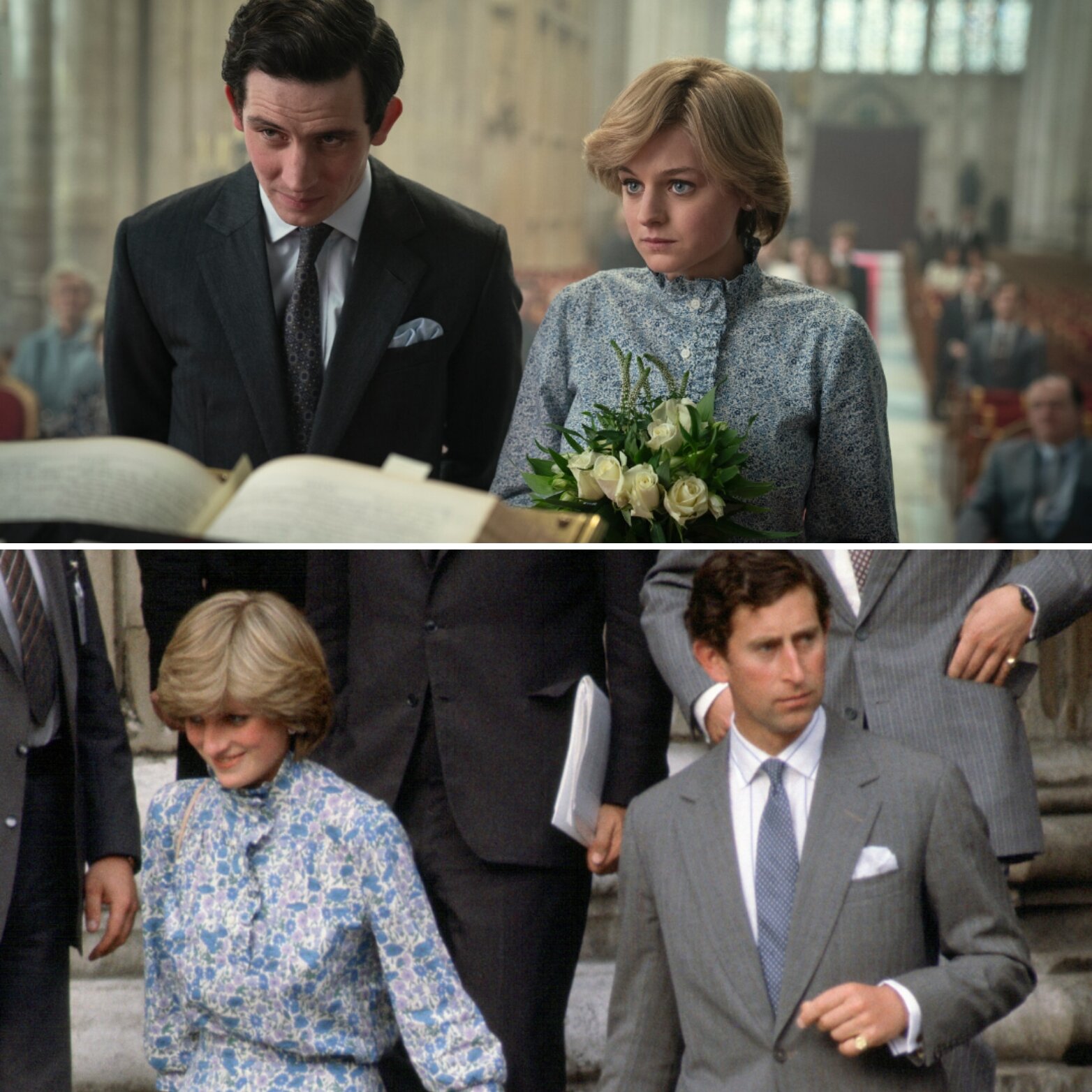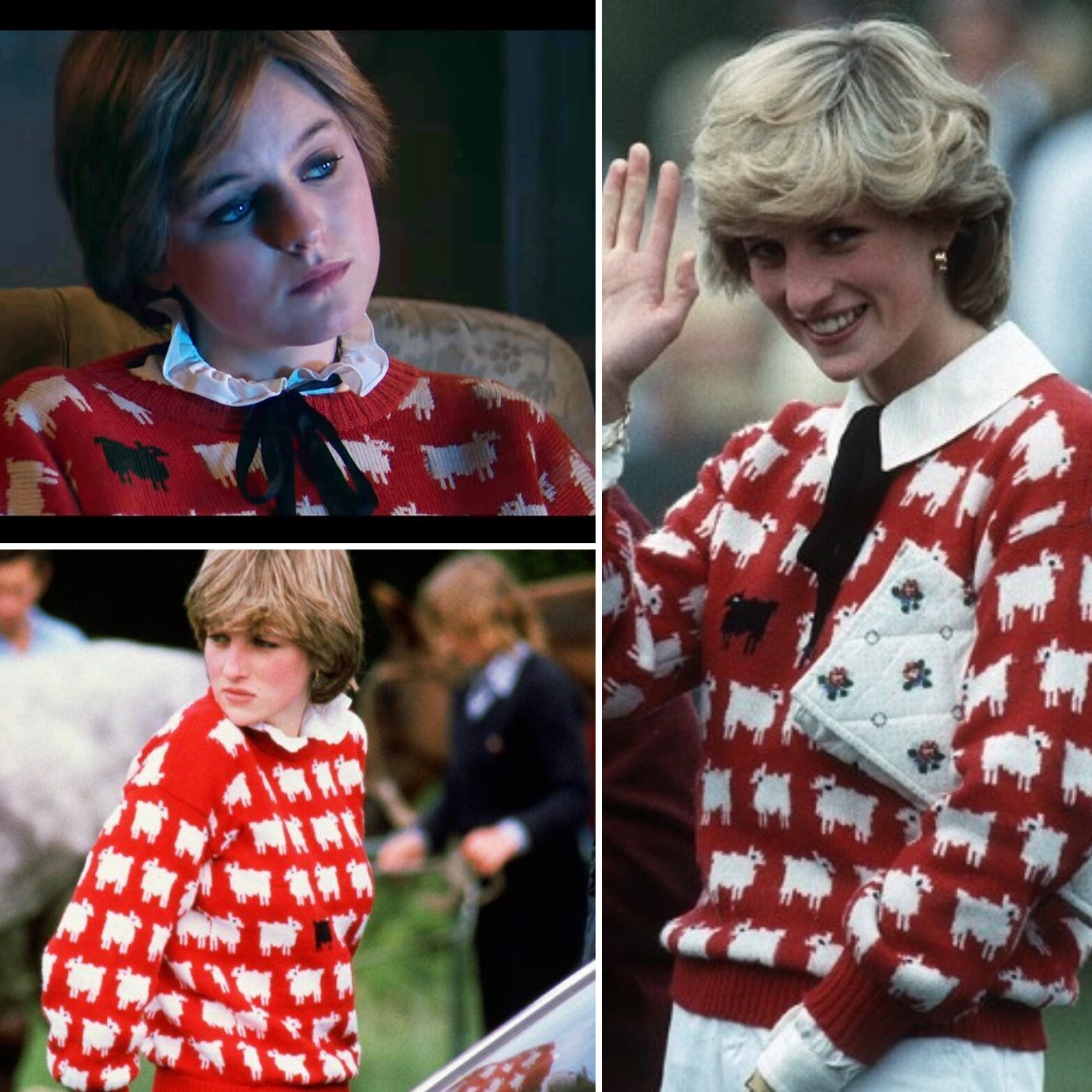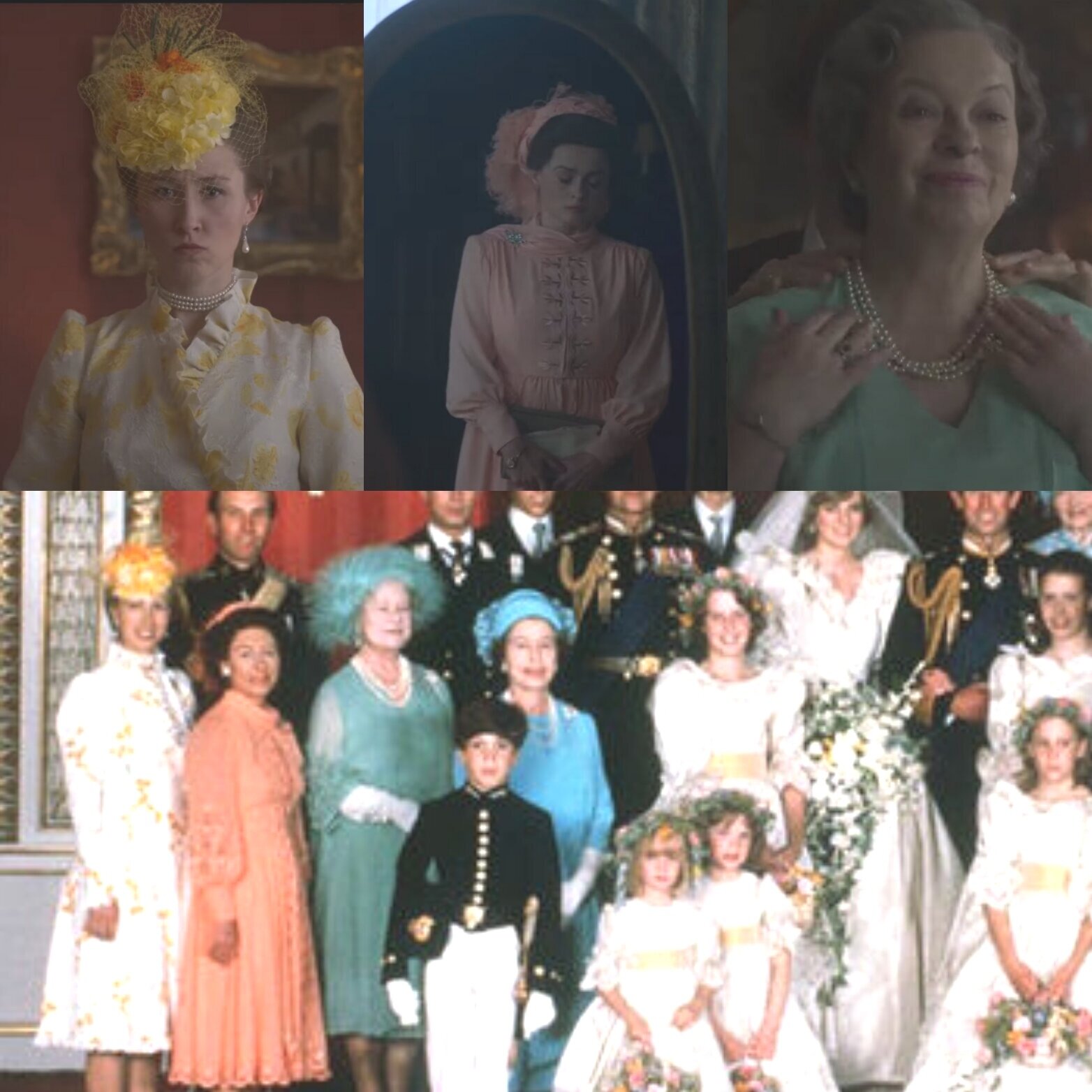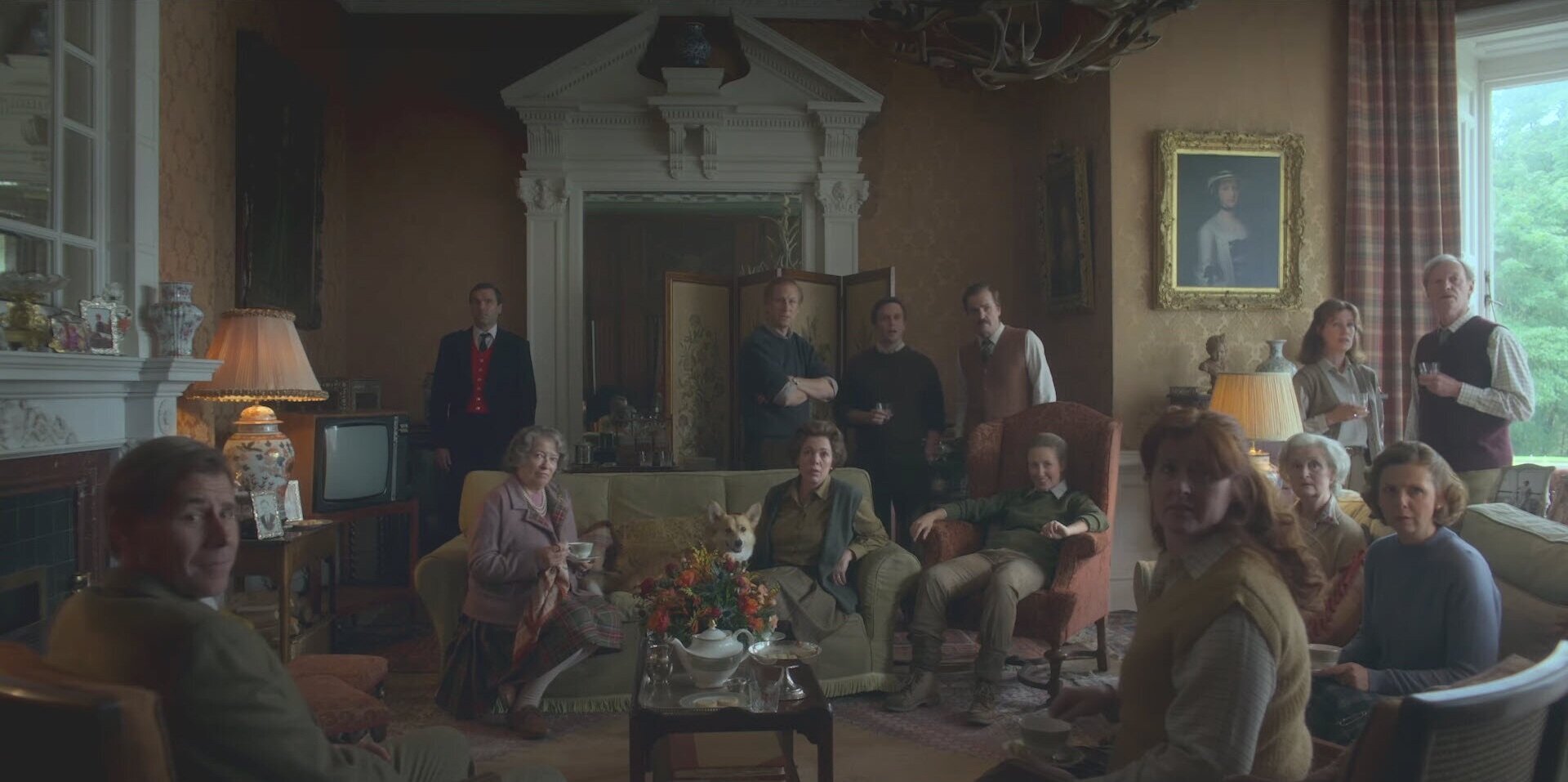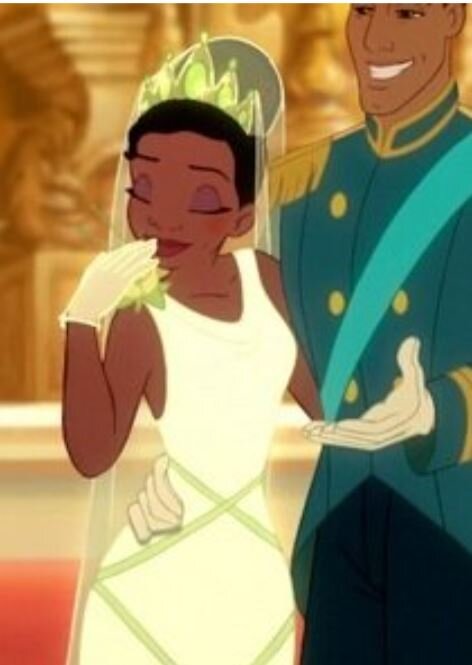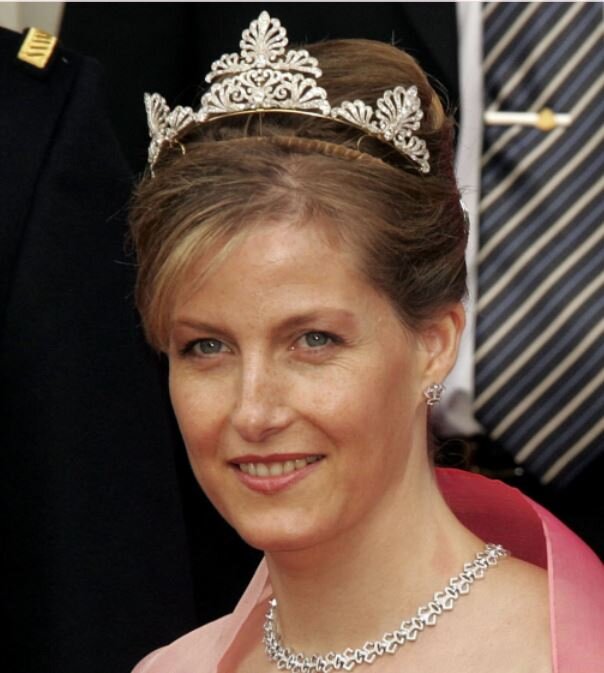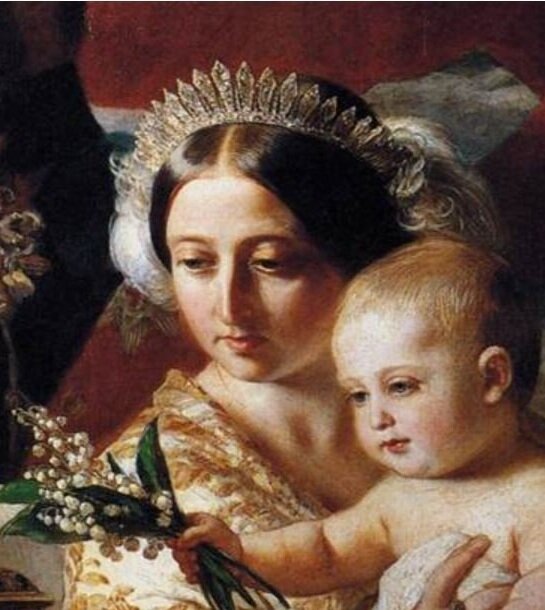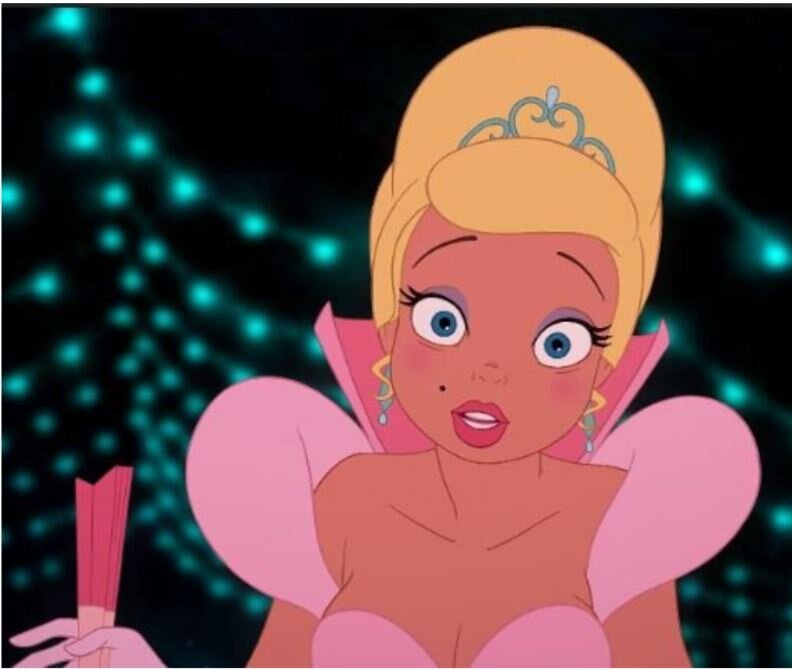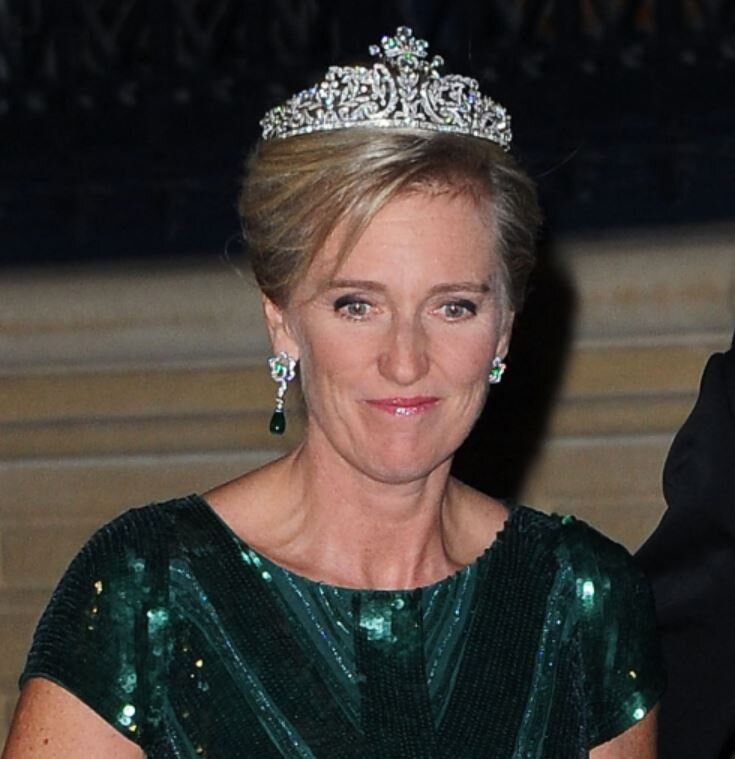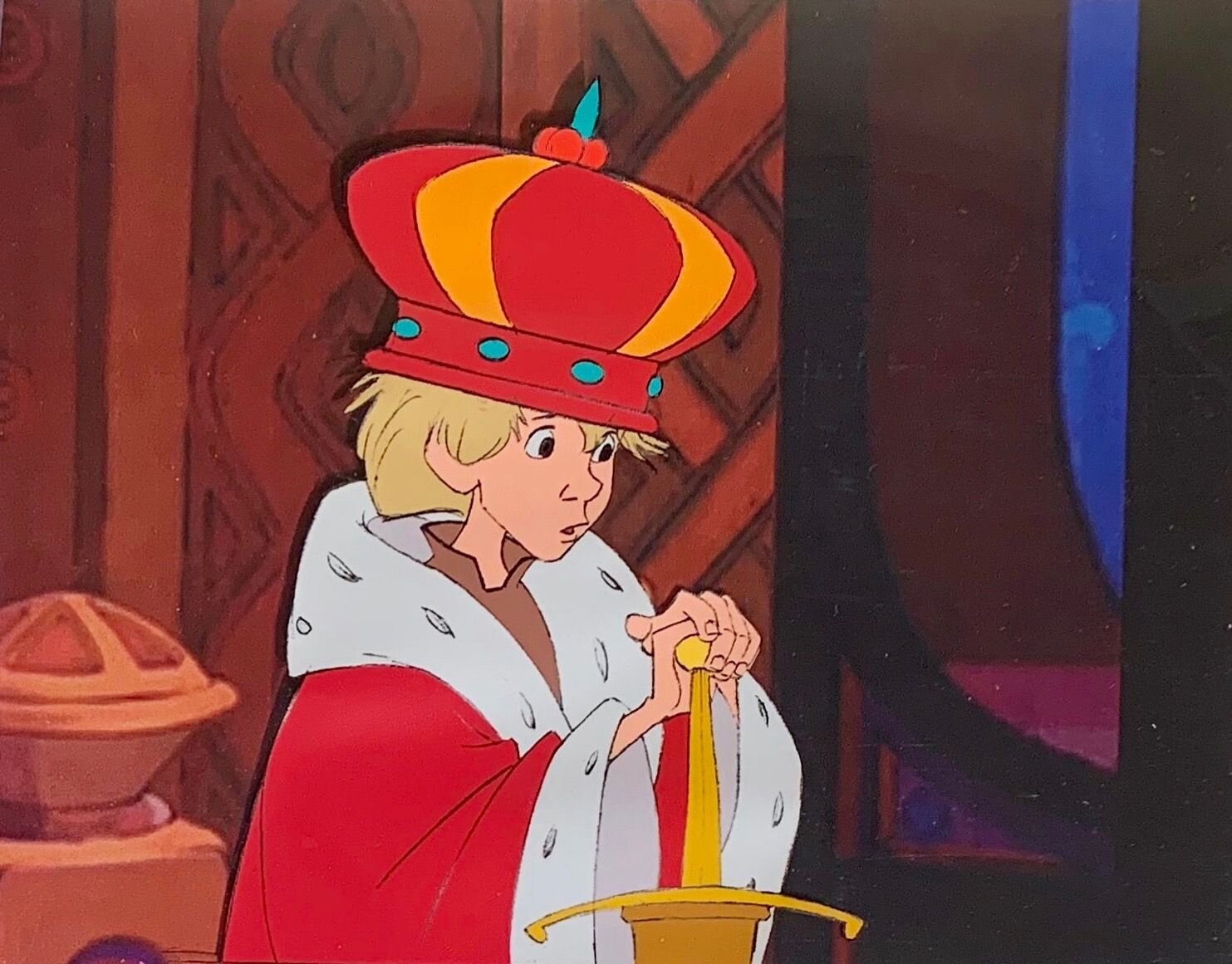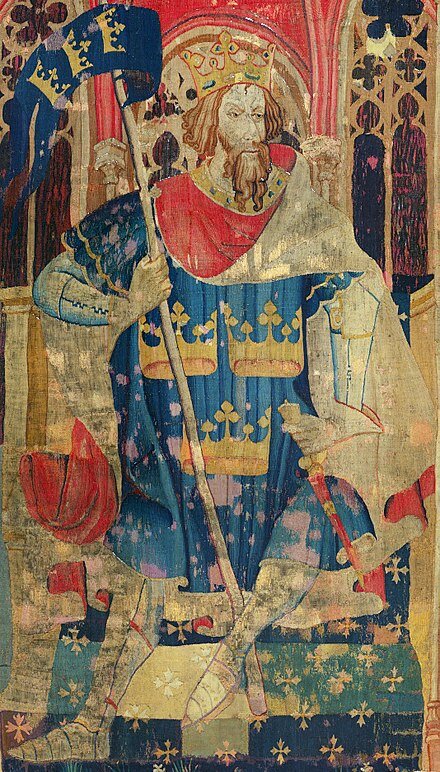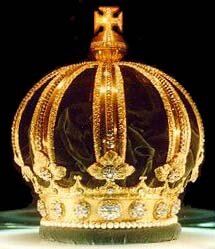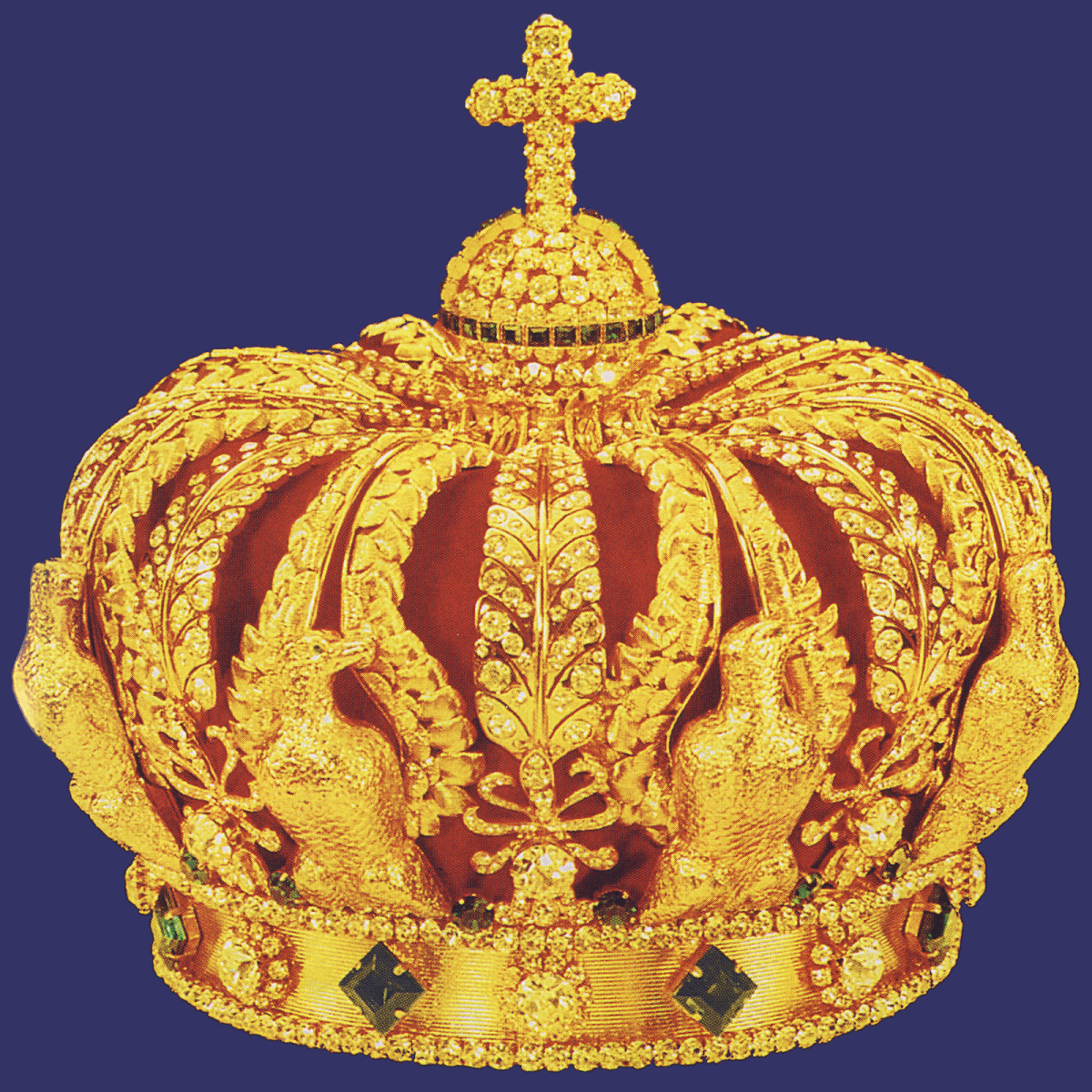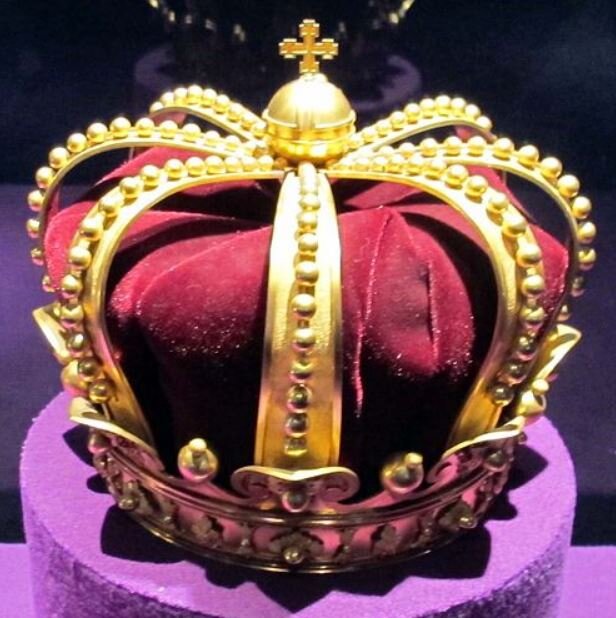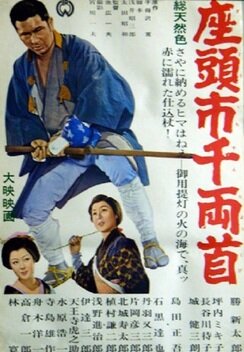Over-Analyzing The Crown: S4E6 Terra Nullius
All My Posts on The Crown
S3: 1 & 2: “Olding” & “Margaretology” 3: “Aberfan” 4: “Bubbikins, 5: “Coup” 6: “Tywysog Cymru” 7: “Moondust" 8: “Dangling Man” 9: “Imbroglio” 10: “Cri de Coeur”
S4: 1: “Gold Stick” 2: “The Balmoral Test” 3: “Fairytale” ( + Cinderella References) 4: “Favourites” 5: “Fagan” 6: “Terra Nullius” 7: ”The Hereditary Principle” 8: “48:1” 9: “Avalanche”
The Medals, Sashes, and Tiaras of The Crown; Tiaras/Crowns Overviews: Season 1 ; Season 2
Since I had great fun over-analyzing every episode of Season 3 of The Crown last year, I’m doing the same thing this year! So if you haven’t watched Season 4 Episode 6 of the Crown yet and don’t want to be spoiled, please stop reading now. :)
Top: Bob Hawke on The Crown; Bottom: Bob Hawke in real life
The episode opens with politician Bob Hawke (about to become Australia’s prime minister) speaking to a reporter on TV, who asks him about Prince Charles and Princess Diana’s forthcoming tour of Australia. Hawke notes that he doesn’t consider this a very important part of his job and expounds on his republican views and his desire to have an Australian head of state. He refers to the queen as a “pom,” which is an Australian slang word used to refer to Brits. It’s not entirely known where this term came from, but the most common theory I found spouted about the Internet is that it’s short for pomegranate and refers to the red cheeks that visiting Brits and new British immigrants to Australia get from the heat and sun there (source: Country Life).
In the show, Hawke also refers to the royal family by saying “You wouldn't put a pig in charge of a herd of prime beef cattle — even if it did look good in a twin set and pearls.” In real life, Bob Hawke’s widow and others stated that he would never have said such a thing about the Queen. This uproar over this portrayal is discussed in this article from The Daily Mail, which also includes a video of the real Bob Hawke talking about Charles’s visit to Australia; what’s interesting, is the interview’s beginning is almost identical to how it’s shown in The Crown (where he says he’s met Charles and found him a nice young bloke), but where the show has Hawke going off and saying various rude things about the Queen, in real life, he was much milder and said, “I don’t think we’ll be talking about kings in Australia for ever more ... we would be better off as a republic. But I don’t think it’s a matter of great importance.” He then continues to talk about his larger concerns, namely, the welfare of people in Australia. (written quotes from that interview are included in this article from The Guardian)Check out how closely the show captured the interview background of the 4 Corners news show just for this single one minute sequence!
Several articles also have reported that Bob Hawke was in fact a republican, but wasn’t nearly as keen on pushing the royals out of Australia as is shown in The Crown. The Australian stated, “The truth is that Hawke never saw the Charles-Diana visit as a chance to advocate a republic. Hawke always got on well with the Queen. He believed Australia should not become a republic until the Queen’s reign ends. This is a testament to the respect most Australians have for her.”
Next, we see Martin Charteris apprising the Queen on the results of the Australia election. The Queen describes Hawke as “the rough, tough former trade union negotiator and the proud holder of the world record for beer drinking.” Charteris said he won it by drinking “a yard of ale in a sconce pot in 11 seconds,” and then notes that Hawke was now a teetotaller.
I found a truly delightful article published in the Australian Times that looks into Hawke’s beer-drinking record in depth that you should totally go read if you have a chance. That article explains the story far better than I ever could: “Oxford University is an institution steeped in quaint tradition, and even more so in the 1950’s when Bob was a student. Students take their evening meal in the dining hall of their college, and are required to attend wearing a gown. Back in Bob’s day, if you turned up not wearing a gown, you were subject to a challenge against the ‘sconce master’ of the college. “Sconcing” is a tradition unique to Oxford University, which demands a person drink a tankard of alcohol, usually ale, as penance for a breach of etiquette — such as forgetting to wear one’s gown to dinner! The story goes that Bob had to drink the yard of ale from a sconce pot faster than the sconce master, or face buying a round for all present. Being unable to afford to buy the round, Bob had no choice but to beat the sconce master. And beat him he did, setting a world record and carving a place in Australian history at the same time.”
The Independent reported in 1994 that Bob Hawke gave up alcohol in 1980 and remained a teetotaller as long as he was prime minister.FUN RIDICULOUSLY SMALL ROYAL REFERENCE: While talking to Charteris in her office, the Queen waters a flower in a pot. I’m not a gardener myself, but this flower looks to be a lily of the valley, which are in fact, the real life Queen’s favorite flower (source: House Beautiful). I could not find any evidence that the Queen actually keeps potted plants or waters them herself (please tell me if you do!), but she did take up gardening at 91 (Source: British Heritage).
The Queen emphasizes the importance of Charles and Diana’s visit to Australia here, implying here and later that it’s their job to persuade Australia to keep in the Commonwealth. In real life, it wasn’t viewed that way at all. The Australian quoted Sir William Heseltine (the Queen’s ACTUAL private secretary from 1986-1990; as I’ve mentioned before, in real life, Martin Charteris retired in the late 70s), as saying “The visit by the Prince and Princess of Wales to Australia, which features large in the series, I can attest was certainly not conceived as a weapon to ward off any move to a republic. It was one in the regular series of visits by Her Majesty herself and members of her family undertaken as one of the ways in which the family showed their devotion to the overseas monarchies.”
Scenes from The Crown.
Diana in real life wearing a wide necked loose green dress similar to one on the show.
Content Warning: Eating Disorders. [italicized]
We get a quick flashback to a lunch with the Queen, Queen Mother, Princess Margaret, and Princess Anne. All of them are wearing similar colors and prints, clearly emphasizing their familial connection, but in their own particular colors and styles. In this scene, it’s implied that Margaret tells the others about Diana’s bulimia (this isn’t explicitly shown, but we do see a quick montage of Diana binging and purging in the middle of the conversation and the royal ladies looking very shocked afterward); she would know best, as Margaret, Diana, and Charles, all lived in Kensington Palace at the time (although Charles spent quite a bit of time out at his home in the country, Highgrove). Margaret lived in apartment 1A and the Waleses lived in Apartments 8 and 9. You shouldn’t expect “apartment” to refer to anything small, by the way; Diana and Charles’s rooms covered three floors (Source: Marie Claire).
To the royal ladies’ credit, they are completely shocked by the news of Diana’s bulimia.These bulimia scenes are incredibly heartbreaking, of course. Diana spoke about her struggles with her eating disorder quite openly later in life. In one interview with BBC, she said, “I had bulimia for a number of years. And that's like a secret disease. You inflict it upon yourself because your self-esteem is at a low ebb, and you don't think you're worthy or valuable. You fill your stomach up four or five times a day - some do it more - and it gives you a feeling of comfort. It's like having a pair of arms around you, but it's temporarily, temporary. Then you're disgusted at the bloatedness of your stomach, and then you bring it all up again. And it's a repetitive pattern which is very destructive to yourself.” She attributed the bulimia to the struggles in her marriage, saying “The cause was the situation where my husband and I had to keep everything together because we didn't want to disappoint the public, and yet obviously there was a lot of anxiety going on within our four walls.”
Princess Margaret, who in the show, was the only one who spoke out openly against the marriage before it happened, saying that clearly neither Diana nor Charles wanted to marry each other, continues her trend as being the most observant member of the family by stating, “People do the strangest things when they’re unhappy”
Content Warning end.
At the royal ladies’ lunch, it’s stated that it was Diana who wanted to take baby William on the Tour of Australia. This is not actually the case. According to her biography by Andrew Morton, she was ready to leave William behind during the tour until the then-prime minister of Australia Malcolm Fraser suggested bringing him along. Apparently it was portrayed as Diana’s idea in the press at the time though.
In the next scene, after a few very quick dialogue-less shots of Charles arriving to play polo with Camilla and her husband Andrew, we see Charles and Camilla laughing, drinking, and telling a bawdy joke together at a gathering of friends. Andrew Parker Bowles is in the crowd, with his arm leaned up on a sofa behind another woman (likely alluding to his own affairs). I think this is mostly to show how happy these two truly are together. Diana is conspicuously absent.
The gaiety of this scene contrasts sharply with the next shot, which has Charles and Diana miserably huddled next to each other on a sofa as they sit across from the Queen, Philip, and a counselor of some sort. Diana has her arms crossed and Charles has his hands clasped together (exposing his ever-present signet ring); their body language indicates that they don’t want to be there and don’t feel close to each other at all. DIana’s in a loose green dress with a wide neck; everything about it seems to emphasize how thin she is (it’s very similar to a dress the real Diana wore on the Australia tour. Couldn’t find a screenshot of the dress in the show, but I’ve included the real life green dress to the right). The Queen and Philip similarly have their hands gathered up separately, but they sit with their legs and body posture facing each other, signifying how close they are and only emphasizing the distance between the younger couple
Left: Emma Corrin on The Crown. Right: Diana in real life (Credit: Tim Graham / Getty).
Top: Diana and Charles with William arriving in Australia (Credit: Bob Thomas / Getty). Bottom: Emma Corrin and Josh O’Connor arriving in Australia on The Crown.
The Queen refers to her and Philip’s tour of the Commonwealth back in 1954, which we saw portrayed in S1E8’s Pride & Joy, and states that it was hard, but brought them closer together. This is hilarious considering that we saw them have a huge fight on that tour, complete with Elizabeth throwing things at Philip. I haven’t had a chance to write about the first and second seasons yet, but apparently their argument in Australia depicted on The Crown actually happened in real life (Source: Express).
Elizabeth’s obliviousness towards her children (shown previously in S4E4’s Favourites) continues when Margaret wryly asks whether leaving her children behind for six months “might have had consequences” by saying “On what? The tour was a triumph.”
Diana’s outfit as they board the plane to Australia is similar to one she wore in real life, but with some key differences. In real life, she wore a navy blue and white striped cardigan; her cardigan on the crown has very colorful stripes that are almost childlike - emphasizing both her youth and her connection to baby William. We get a fight on the plane between her and Charles’s long-suffering private secretary Edward Adeane (who yes, was the son of Michael Adeane, who was private secretary to Queen Elizabeth from S1-S3, the one who Philip gave a clock and then promptly forgot about) about being separated from William for two weeks, but as I previously mentioned, in real life, she actually hadn’t insisted on bringing William along. William stayed primarily at Woomargama and the prince and princess visited him several times during the trip. This entire scene is basically just added for drama and to illustrate how different Diana is from the rest of the royals.
One thing this scene does illustrate though, is Diana’s views on motherhood. She states, “the greatest service I can give the royal family is to be a living breathing present mother – to this child who will someday be king.” Insider has an article talking all about Diana’s approach to raising her sons which is pretty good, although it does repeat the tired, disproven story that Diana insisted on taking William to Australia.There’s a really adorable Town and Country article all about the effect William’s stay at Woomargama Station had on the little town. It’s just. So cute.
Next we see Charles and a very unhappy Diana getting off the airplane in torrential rain with baby William. In the show, a newscaster notes that in Alice Springs, they’d received more than a month’s rain in a week. Diana says goodbye to William tearily, as Charles snaps at her to get going.
In real life, the whole Wales family arrived in apparently good spirits on a sunny day. A UPI article from 1983 confirms this, noting that the couple were greeted at their stop in Alice Springs “in brilliant sunshine.” I get why The Crown did this though, as in reality, there HAD been several days of torrential rain and flash floods that disrupted the entire area right before the royal couple arrived. In fact, the rain and floods were so bad in the area that the casino hotel that the couple planned to stay in was inaccessible except by helicopter; they had to make do with a motel that stood on top of a ridge. This wasn’t shown on The Crown, of course, but it would have been interesting to see. Commentators at the time claimed that the motel stay was a “royal first.”
There was one contrasting report from The Age in 1983, which said “She seemed uneasy, even glum, and looked at the tarmac with downcast eyes throughout much of the brief airport picture session.” This is not demonstrated in photos of the event though. At the very least, if she was visibly unhappy, it wasn’t to the extent shown in the show. However, Diana was very good at hiding her feelings. Years later, she said to Andrew Morton (who wrote the biography Diana: Her True Story), “I’ve got what my mother’s got. However bloody you’re feeling, you can put on the most amazing show of happiness.”The Crown also shows the royal family going essentially directly to a press conference to talk to a horde of journalists, where Diana stumbles over her words and accidentally calls “Ayers Rock” “Ayers Dock,” to titters in the audience and the ridicule of the prime minister (watching on his tv set). I couldn’t find any evidence that Diana actually made that large of a gaffe, but Charles DID joke that baby William was being fed “warm milk and minced kangaroo,” which um, angered some people (Source: Meaww).
Bob Hawke is shown briefly mentioning that there are protests in Canberra about the cost of Charles and Diana’s visit. I couldn’t find ANY evidence of this happening at the time. Please tell me if you do and I will HAPPILY add that information in here. Maybe I just wasn’t using the right magical keywords to appease the Google gods.
I did find a bit about protests happening in New Zealand? The Telegraph says: “Nor was the couple’s two-week stay in New Zealand trouble-free. On their way to a banquet in Auckland their car was hit by an egg filled with red paint, and in Wellington a Maori bared his buttocks at the couple in a protest over land rights.”
Olivia Colman as Queen Elizabeth II watching film from her 1954 visit to Australia in The Crown
We get a scene of the Queen reminiscing over her glory days while watching a film of her visit to Australia in 1954. These appear to be film strips of the real Queen and Philip, not Claire Foy and Matt Smith. Philip hears the music of the film and joins her. They talk a bit about the size of the crowds, citing that over a million people turned out to see them in Sydney. This will become important later.
Philip asks why the Queen sent Charles and Diana to Australia, stating that the country was too important “to send out the understudy.” As I mentioned already, there weren’t any serious fears that Australia would get rid of the monarchy or any need for the royals to keep Australia in the fold; this was a planned, regular visit just like Philip and the Queen’s in 1954.Later, we see Diana struggling with the heat at Ayers Rock (now known as Uluru) and unable to climb the tourist site. In real life, it appears that Diana hesitated because of her unsuitable dress and shoes, not due to heat or illness. The Sydney Morning Herald at the time reported “As she stepped off the plane at Ayers Rock, she looked down in horror. Her dress, buttoned down to the front, was immediately blown open revealing her petticoat and knees. From that moment, the Princess made constant but hopeless attempts to keep the dress closed."
In reality, the royal couple did actually climb Ayers Rock. However, the show didn’t depict this, as Uluru is actually a spiritually important place to the Anangu (a name referring to several aboriginal Aaustralian groups); climbing of it was banned in October 2019 (Source: The New Daily). Although The Crown shot this scene in Spain, not Australia, and digitally added in the rock in post-production, the fact that they didn’t show them climbing the whole rock illustrates the series’ attempts at cultural sensitivity. Apparently some of the footage of this scene in The Crown also features archival footage of traditional land custodian Reggie Uluru; Netflix made a donation to a Mutitjulu community charity in return for this (Mutitjulu is an aboriginal community in the area and the home of Reggie Uluru).Later, Charles complains to Camilla about Diana on the phone. This hearkens back to what Charles told his mother in S4E4 “Favourites,” namely, that he called Camilla when he needed cheering up. In this conversation, he refers to Diana as a child and says he misses Camilla’s adulthood.
Note that he calls Camilla “my darling” on the phone. This will become important later.
Top: The Crown
Bottom Left: Charles and Diana at Ayers Rock (Credit: TIm Graham / Getty).
Bottom Right: Charles and Diana at Uluru (Credit: Princess Diana Archive / Getty).
Left: The Crown
Top Right: Charles and Diana (Credit: Princess Diana Archive / Getty).
Bottom Right: Charles, Diana and baby William (Credit: Tim Graham / Getty).
We get another argument of Diana arguing with Edward Adeane over her need to see William. In real life, the royal couple visited William in Woomargama several times throughout the trip. It appears that these visits were always planned.
After the royal couple arrives at Woomargama, The Crown shows Diana and Charles playing happily with William in front of photographers, recreating a famous picture from the time.
Next is a scene of Charles and Diana out at Woomargama talking about William while their baby naps, the one thing they seem to have in common at this point in the episode. Charles notes affectionately that he was “crashing and bashing into everything” and also calls him “a mini tornado.” This is very accurate to real life. Charles once recounted a similar event in a letter to a friend, noting that he and Diana had enjoyed watching William crawling around “at high speed knocking everything off the tables and causing unbelievable destruction” (Source: Elle).
Their conversation about their relationship is very beautifully done, like a scene from a play. The showrunner of The Crown was, of course, originally a playwright. Charles acknowledges how unhappy Diana is; Diana asks him how she’s supposed to feel about his relationship with Camilla. She specifically refers to the bracelet incident (which was shown in S4E3 Fairytale), his wearing “CC” cufflinks Camilla gave him, and a picture of Camilla falling out of his diary on their honeymoon. The cufflinks and picture incident were both mentioned in Andrew Morton’s “Diana: Her True Story in Her Own Words,” which was based on extensive interviews with Diana herrself.
At the climax of the confrontation, Diana points out that Charles and Camilla are perfect for each other and asks angrily “So where do I fit in?” Charles responds, “You fit because you are my wife. And I love you.” This conversation echoes reports from many of Charles’s friends that Charles did, in his own way, actually love Diana, at least in he early years of their marriage. The lines indicating that they are in fact, very similar and both need more encouragement and appreciation, also echo reports from people who knew both of them. By the end of the conversation, they recommit to their relationship and promise to encourage and lift each other up more. Charles’s last line in this scene is “Happy Easter, my darling,” which, you’ll note, is exactly what he called Camilla just a few scenes earlier.
I do greatly enjoy that they’re literally celebrating Easter by hanging out and playing with sheep.
Left: The Crown
Right: Princess Diana (Credit: Princess Diana Archive / Getty).
Top: The Crown; Bottom photos: Diana and Charles
Left: The Crown
Right: Charles and Diana (Credit: David Levenson / Getty).
The next few scenes show the couple at their best, happily greeting crowds in a variety of different Australian cities, most notably Sydney, where they’re positioned right outside the opera house. Diana’s outfits are very similar to what she wore in real life, but not always exact copies, as you’ll see above.
Although I couldn’t find figures on the size of the crowds at the time (except in Melbourne, where 200,000 turned out), everyone seems to think that this tour signified the start of Diana-mania.
The Telegraph reported: “On a more serious note, police in Australia had vastly underestimated the size of the crowds that would turn out to greet the couple. A senior officer famously said: ’We haven’t seen this in royal tours here before. It is more akin to Beatlemania.’ Thus was the phrase ‘Dianamania’ coined by the tabloid press. The couple often ran late because of delays caused by the crowds, leading to a frenetic atmosphere among those waiting in the heat. Children became separated from their parents in the crush, hundreds of people fainted, flowers and flags were thrown at the couple, and police became seriously concerned about crowd surges. Police numbers were increased by 25 per cent. By the time the couple visited Tasmania ten days into their tour, local police were warned by their counterparts in Canberra to step up crowd control because of ‘an element of hysteria’ that had been evident in crowds in Sydney.Content Warning: Eating Disorders. [italicized]
Although The Crown shows the crowds exciting and invigorating Diana, in real life, she found the attention overwhelming and exhausting. Sally Bedell Smith, who wrote a biography about Prince Charles, said “For her part, Diana was upset by the disproportionate interest in her, especially when she realized that it was disturbing Charles. She collapsed under the strain, weeping to her lady-in-waiting and secretly succumbing to bulimia. In letters to friends, Charles described his anguish over the impact ‘all this obsessed and crazed attention was having on his wife.’” This strain become most publicly apparent when Diana burst into tears in the midst of a crowd at the Sydney Opera House; the scene was caught by photographers, but apparently overlooked by Charles at the time.
Content Warning end.
Left: The Crown; Right: Princess Diana (Credit: Anwar Hussein / Getty).
Left: The Crown; Right: Princess Diana (Credit: Tim Graham / Getty).
The beautiful scene of Charles and Diana dancing recreates some very famous photos of the couple dancing together in Australia, in pretty much the exact same outfits. I did find actual video of their dancing; although they dance to “Can’t take my eyes off of you” in The Crown, it’s a different song in real life (I haven’t figured out which one, but if you do, please let me know!)
Afterward, Charles joins Diana in her room. We know that despite their unhappiness, the couple did uhm, at least have some fun together after this 1983 Australia trip, as Prince Harry was born in September 1984.
In the next scene, Charles is having breakfast and is told that Camilla is on the phone; he refuses the call. On The Crown podcast, actor Josh O’Connor said that he had been instructed to think of Camilla as sort of like a bad habit that he’s trying to quit - every time he says “this’ll be my last camilla” and yet he always ends up going back to her. This seems to show one of his attempts to leave Camilla behind. (In the podcast, the actor acknowledged that this was an incredibly reductive way of viewing an actual person, but said it was a good tool for him to understand the situation. Emerald Fennell, who plays Camilla, was NOT a fan of this approach when she heard about it).
They have a wonderful appearance on a radio show in which Diana says, “I don’t think of myself as royalty, first and foremost I’m a wife and a mother, that’s what is most important thing to me.” This is very similar to something she said in real life: “Most importantly, [my role is] being a mother and a wife. That's what I try to achieve; whether I do is another thing, but I do try.” (Source: Little Things). In The Crown, she also notes “his favorite cuddly toy used to be a whale. Now it’s a koala.” In real life, she really did tell a reporter that William had a koala he loved now. I didn’t find anything referring to his formerly loving a whale, but this was likely chosen because Charles and Diana were Prince and Princess of Wales.
In the next scene, we have the coolest shot following a woman getting out of a pool, getting out, and going over to the edge of the building’s roof, where she joins others waving down at Diana and Charles, surrounded by gigantic crowds of people. This is an incredibly effective way of signifying the Diana mania. Diana is shown talking to many people in the crowd in a very friendly, interested way, illustrating her real life talent at connecting with people. Diana really was swarmed by a crowd at one point. Again, she’s wearing an outfit incredibly similar to what Diana wore in real life.
Footage of Diana in the crowd is shown on TV as the Queen and Princess Anne watch during a joint uniform fitting. Anne smartly notes, “There’s a problem that nobody expected,” pointing out that Diana’s intense popularity (drawing “bigger crowds than [the queen] got back in the 18th century or whenever”) was sure to upset Charles. “You and I both know how much Charles craves attention, reassurance and praise – it was supposed to be his debut. Instead, it’s Diana’s.” Anne also bitterly notes that people are commenting on “what a natural mother [Diana] is,” hearkening back to her words about being constantly compared to Diana back in S4E4 “Favourites.”
Anne’s prediction is quickly shown coming true in the Australian scenes. Charles appears at a polo match and the crowd calls to ask where his wife is, saying “we only came to see princess Di.” Charles ends up falling from his horse, which can’t have made him happy, and people chant “We want Di! We want Di!” In contrast, Diana is off posing with some swimmers, and then greeting some sick children to uproarious acclaim.
The final straw for Charles seems to come when he speaks at a dinner; his comments about Diana are greeted with laughter as Diana blushes at the compliment prettily in the background. He takes this badly and interprets it as "her pulling faces.” During their fight, Diana points out “Thanks to me, people have shown up.” Charles shouts, “People are laughing in my face, booing the heir to the throne, booing the crown.”
During this whole scene, Diana wears a red dress with sparkly polka dots on it which combines two real life dresses. She’s also shown wearing the Spencer Tiara, her family tiara. As the blog The Court Jeweller has noted, the tiaras on The Crown unfortunately tend to be just enough larger than the real life things to look slightly absurd.
Top Left: Charles and Diana in The Crown; Top Right: Charles and Diana
Bottom Left: Diana in The Crown; Bottom Middle: Diana (Credit: Princess Diana Archive / Getty). Bottom Right: Diana (Credit: Tim Graham / Getty).
Top: The Crown; Bottom: Prime Minister Bob Hawke, Hazel Hawke, Prince Charles, and Princess Diana (Credit: Princess Diana Archive / Getty).
In the next scene, the royal couple meets the Australian Prime Minister and his wife. The PM talks to Charles and tells him that if Diana hadn’t been with the prince, Australia might have shaken off the royals (which must have done GREAT things for Charles’s insecurity). Hawke notes, “That superstar may have just set back the cause of republicanism in Australia for the foreseeable future.” (remember though, this wasn’t a real concern either for Hawke or the royals at the time.
The PM also makes reference to “terra nullius” (Latin for nobody’s land), which is what George III called Australia when the British first arrived. This seems to refer to Charles and Diana’s efforts to strike out new territory in their marriage and ultimately failing. Their attempts to save their relationship are based on basic misunderstandings about each other’s characters, just as Britain’s takeover of Australia was based on (deliberate) misunderstandings about that land and the people there.
The costumes are pretty close to how they really were in real life, although the PM’s dress is different in shape. My one big quibble though is that in the show, Diana’s anxiety over the state of her marriage and Charles’s anger towards her popularity is obvious on her face; Diana was well known for putting on a good face when she was miserable, which is partially why it took so long for the public eye to realize that the marriage wasn’t a fairy tale.
After this, we get a montage of quick scenes of the couple touring in New Zealand just like the one we got earlier in the episode showing them around Australia. However, although the earlier montage was very happy and showed the couple’s increasing closeness, this montage only emphasizes how unhappy both of them are. We get some shots of Diana staring in the mirror with dark circles under her eyes and crying while lying in bed. The tour ends with the couple getting off the plane in England in the rain and getting into separate cars that are literally heading in separate directions; Diana goes to Kensington Palace while Charles goes to Highgrove.
Diana instantly calls the queen and asks to see her. This is a super quick scene, but while talking on the phone, Diana is shown wearing a white nightgown and a robe with ruffles all down the sides, which match the ruffled curtains behind her. Kensington Palace is clearly HER home that she designed and loves; she is the one that belongs here.
Top Left: The Crown.
Top Right and Bottom Left: Princess Diana (Credit: Princess Diana Archive / Getty).
Bottom Middle: Princess Diana (Credit: Mirrorpix / Getty).
Bottom Right: Princess Diana (Credit: Kypros / Getty).
Diana arrives at Buckingham Palace in a green and red tartan dress with a big white collar that calls back to similar tartan outfits she wore at Balmoral in S4E2 The Balmoral Test and during princess lessons in S4E3 Fairytale. Since I’ve already pointed out similar real life tartan outfits in my blog posts on those episodes, I looked at real life Diana outfits with a similar neckline and similar coat this time instead; there are plentiful examples.
The Queen watches at the window for her arrival, which both hearkens back to the way she saw Diana at Balmoral in S4E2 and also illustrates her anticipation of why her daughter-in-law is there. She walks in quickly and never takes off her big dark blue coat during the entire scene. In the story, this is clearly because she’s too upset to even consider it. Thematically, it seems like she wants to go somewhere else, away from her marriage; she already has her coat on and is ready to go. The coat actually covers up the tartan for most of the scene; in the screenshots I’ve found of it, the dress appears black.Diana refers to the Queen as “Mama,” which clearly startles Elizabeth. Diana really did call the Queen “mama” in real life, as does Prince Edward’s wife Sophie, Countess of Wessex and Prince William’s wife Catherine, Duchess of Cambridge (Source: Marie Claire). Note that when the Queen sits down, she’s backed by pictures of Charles’s investiture as Prince of wales from S3E6 Tywysog Cymru, which indicates her long-standing connection to her son vs. her shorter acquaintance with Diana, and also refers back to the first time we saw Charles really struggling with his role as prince of Wales in the series (we did see him struggling with his father’s expectations of him back in S2E9 Paterfamilias, but not quite in the same way).
Diana begins by saying that she’s come to the queen because she’s struggling. The Queen, sitting in front of a table full of positive coverage of Diana, asks why, as she’s just had a triumph in Australia; echoing her language about her own 1954 tour earlier in the episode (which then, illustrated her indifference toward her children). Diana responds by saying that she didn’t consider it a triumph if at the end of it, she and Charles are “wretchedly unhappy” behind closed doors and then goes on to say, “He resents me, resents the attention I get.” The Queen asks why he resents her and Diana says she doesn’t know, and that’s why she’s come to ask his mother.
The Queen ends up taking offense at Diana’s words and asks if she’s saying that Elizabeth and Philip have been terrible parents (which Diana strenuously denies), hearkening back to the earlier conversations with Princess Margaret and Princess Anne. She then notes that she herself also struggles to understand Charles too, but that “us sitting here sticking knives in him isn’t helpful either.”
Elizabeth also quietly notes that perhaps Diana is playing to the crowd a bit too much and overdoing it, saying “We do all know when we’ve played to the gallery excessively.” Diana agrees slightly, but also says that she’s doing the best she can, as she was thrown into the deep end of being a royal with no help or assistance (in real life, she was even less prepared than she was in The Crown. She was certainly never given any princess lessons like those shown in S4E3 Fairytale). Diana then emphasizes that all she wants to do is play for the team and be part of it, but feels resented by most of the family, and begs for the Queen to help her by showing her love, approval, and acceptance, saying that she believes the rest of the royals would follow suit.In real life, the Queen and Diana were relatively close at the beginning of her marriage to Charles, as Diana came to call on her for advice several times. Eventually though, the Queen began to really dread Diana’s visits, as the princess would often cry during them. (Source: Reader’s Digest). I don’t know of any specific incidences regarding the Queen being startled by Diana hugging her though; I couldn’t find any references to it.
The Queen tries to dismiss Diana but her daughter in law ends up hugging her for a long, sickening moment, as the queen stands there in shock, unsure what to do. Diana tells her that love and acceptance is all she wants from her, all that ANYONE wants from her, and at that, the Queen promptly flees the room. People generally are summoned into and dismissed from the Queen’s presence, so this signifies how rattled the Queen actually is to just leave herself.
The episode is bookended by another luncheon scene with the Queen, Queen Mother, Princess Margaret, and Princess Anne, in which the others react with shock to the news of Diana hugging the Queen. Anne actually says “I feel sick.” Although people rarely hug the queen and it’s generally seen as a breach of protocol, the Queen doesn’t actually seem to mind it when it happens. After Michelle Obama rather famously hugged the Queen in 2009, the Guardian reported that at least four other people have been known to hug the queen: a community activist named Alice Frazier who met her on her U.S. tour in 1991, Prime minister of Australia Paul Keating in 1992, Prime Minister of Australia John Howard in 2000 (although he disputes this), and Canadian cyclist Louis Garneau in 2002. The queen did not object or seemingly mind the hugs on any of these occasions. There have also been numerous photos of the Queen being kissed on the cheek by various family members (including Princess Anne). Since the royal family is obviously more reserved in public than they are in private, it’s certainly likely that they would hug at their own private family gatherings.
There are also lots of photos and reports of the younger royals, Princess Diana, and even Prince Charles hugging fans.
It seems like the Queen really did think that Diana needed to just get on with it and deal with her unhappy marriage (source: readers digest). The Queen was from a different time in which it was pretty much expected that you’d ignore the problems under the surface and carried on (see, how the Queen approached most of her marital problems with Philip in Seasons 1 and 2 really quietly). Diana was clearly not made for that life and didn’t want to hide how miserable she was.
Left: Olivia Colman in the Crown
Right: Diana on the tour of Australia (Credit: David Levenson / Getty).
The fact that in this scene and in her scene with Diana, the queen is dressed in a very similar print to one Diana wore in real life does seem to indicate that she heard her and sympathized with her, but wasn’t sure how to help her or what to do. She appears to still be considering her experience with Michael Fagan from the previous episode, as she points out that the crown stays relevant by changing with the times, and perhaps Diana has a point.
The Queen Mother has a particularly heartless moment in which she calls Diana an immature child and notes that Diana, like Philip, will someday give up her struggles and bend, and when she bends, she will fit. When the Queen asks – “what if she doesn’t?” – Princess Margaret says, not unfeelingly, but prophetically, “then she will break.” This ties Diana and Philip together again, and points to Philip’s struggles with his role as the Queen’s consort seen throughout season 1 and 2.
Alas, the Queen Mother and Diana really didn’t seem to get along very well. The Queen Mother was extremely close to Charles and also seemed to be predisposed to dislike Diana, as her lady-in-waiting Lady Fermoy was Diana’s grandmother (who testified in court that Diana’s mother was unfit to care for her children) and generally didn’t get along with Diana (Source: GoodTo, quoting Andrew Morton’s biography).
The very last shot of the episode has Diana back at Kensington Palace, blending in with the ruffled curtains in her ruffled nightgown, sitting at the window just as she did in S4E1 Gold Stick, back when she was a young teenager full of hope and excitement about Prince Charles visiting her sister. She looks very young and very alone and lost, very much like the child the Queen Mother just called her. Keep in mind, at this point in the story, Diana is only 21.



























